PORT TOWNSEND — Although recent tests on Port Townsend’s reservoirs have discovered they contain blue-green algae, which can create toxins, the water is safe for drinking, city officials said.
City Manager David Timmons said Wednesday that results of tests for toxins, which arrived Sept. 20, showed levels lower than the minimum detection level.
“Basically, they couldn’t find any toxins,” Timmons said.
Lords Lake and City Lake are both untreated reservoirs and both saw high algae cell counts in tests conducted at the end of August.
City Lake contained a count of 8,900 cells per milliliter while Lords Lake had a slightly slower count, according to Port Townsend water resource manager Ian Jablonski.
A count of 2,000 cells per milliliter is enough to require follow up testing for toxins that could get into the drinking water.
“The tests came back at a low level, but the state requires a response plan at levels lower than we saw,” Timmons said.
“We were basically just preparing for the worst case, but what we didn’t want to do is panic the public.”
According to Timmons, the city was preparing an alternative drinking water source of bottled water should the tests show there were toxins in the drinking water and a “do not drink” order would have been put into place.
“There is a 10-day exposure limit and we were well within that,” Timmons said.
Blue-green algae occurs naturally in lakes and sometimes can begin to produce toxins. Anderson Lake, for instance, is often closed to fishing during the season because of high levels of anatoxin-a, a nerve poison. Another toxin that has been seen in Jefferson County lakes is microcystin, which can damage the liver with long-time consumption.
This is the first time the city has had an algae issue that could have affected drinking water, Timmons said.
Some of the toxins associated with blue-green algae blooms can be eliminated with a simple chlorine treatment that is standard to Port Townsend’s water treatment. However, other toxins require special chemicals.
“We were preparing a plan that would last us until we’d be able to add these new procedures,” Timmons said.
Jablonski said there is no easy way to get rid of algae in reservoirs.
He added that algae growth has been fueled by high water temperatures and sunny conditions.
“We’ll continue to test until the count drops down to below minimum levels,” Jablonski said. “It should begin to drop when it cools down.”
________
Jefferson County Editor/Reporter Cydney McFarland can be reached at 360-385-2335, ext. 55052, or at cmcfarland@peninsuladailynews.com.

